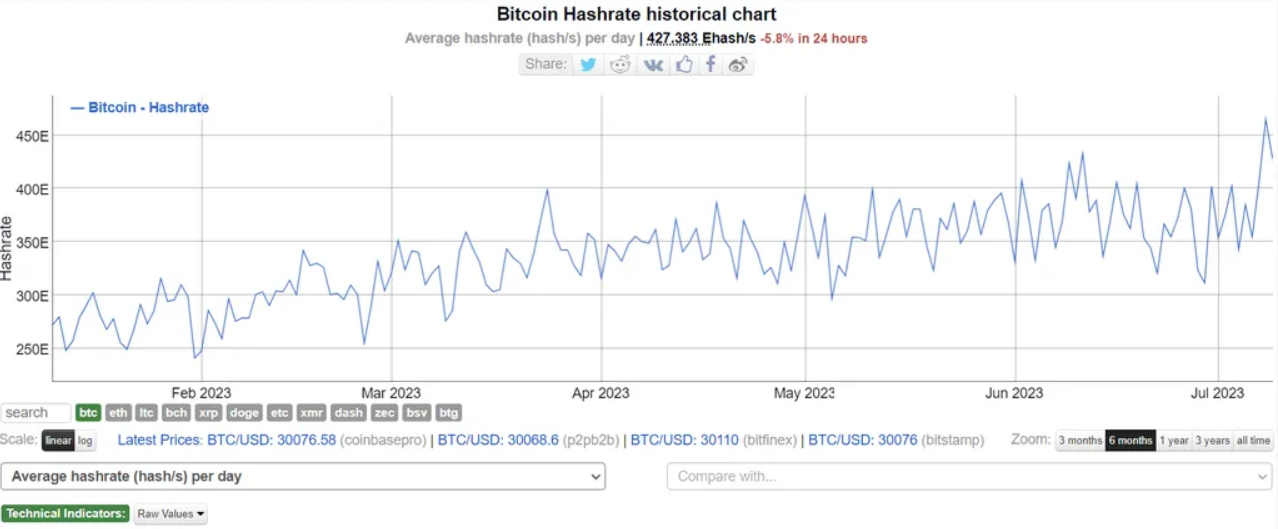- In the world of Proof-of-Work (PoW) cryptocurrencies like Bitcoin, hash rate is a critical metric that reveals the health and security of the network.
- An increase in hash rate makes the network more secure but also brings some challenges for miners, including increased competition and the need for additional resources for more powerful mining hardware and cooling systems.
- A higher hash rate is directly associated with a stronger and more secure network, creating strong barriers against anyone attempting to compromise its integrity.
The hash rate of Bitcoin has reached an all-time high, but why is the hash rate increasing and what does it mean?
Bitcoin Hash Rate Sets New Record

The hash rate of Bitcoin (BTC) has reached a new all-time high, making it increasingly difficult for any individual or group to control over 50% of the total computational power of the network.
According to data, Bitcoin’s hash rate reached 465 EH/s on Saturday. Although it dropped by more than 6% on Sunday to 428 EH/s, the hash rate of the world’s leading blockchain network remains at its highest levels.
In the world of Proof-of-Work (PoW) cryptocurrencies like Bitcoin, hash rate is a critical metric that reveals the health and security of the network. It serves as a measure of the estimated computational power committed to supporting the Bitcoin ecosystem and encompasses significant activities such as mining, key generation, and block verification.
By analyzing the hash rate, particularly in scenarios such as the feared 51% attack where an entity gains control of the majority of the network’s computational power, one can gather information about the network’s resilience against attacks.
A higher hash rate is directly associated with a stronger and more secure network, creating strong barriers against anyone attempting to compromise its integrity. As the hash rate increases, the difficulty level for potential attacks exponentially rises, making the network more resilient against malicious actors.
While an increased hash rate makes the network more secure, it brings some challenges for miners. These include increased competition and the need for additional resources for more powerful mining hardware and cooling systems, which can lead to higher energy consumption.
Miners can sell the coins they produce to offset the rising costs, but falling prices may require them to sell more Bitcoins for the same value. At the time of writing, Bitcoin was trading at $30,263, marking a 0.08% decrease in the last 24 hours.
What is the reason behind the increase in Bitcoin’s hash rate?
According to the Hash Rate Index report, one potential reason for the recent increase in Bitcoin’s hash rate is the return of Texas-based miners to full (or near full) capacity.
The report states that the scorching temperatures have remained “too weak to cause significant issues” for the state’s power grid, allowing miners to continue their operations as usual. This development is also expected to lead to an increase in Bitcoin mining difficulty, with a regulation anticipated to exceed 7.5% this weekend.
Mining difficulty represents a value that signifies the computational power required for mining a single Bitcoin. It becomes more challenging when more miners join the network and easier when they leave, adjusting approximately every two weeks.
The authors of the report stated:
“There are thousands of other miners worldwide who can grow their capacity if they so choose, so the growth is not just from Texas. Regardless of where it comes from, the result is the same: The next difficulty adjustment will be an absolute disaster.”
According to data, after three consecutive positive adjustments, Bitcoin’s mining difficulty experienced a 3.26% decrease on June 29th.

